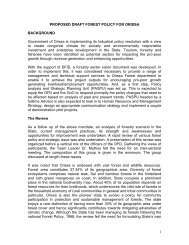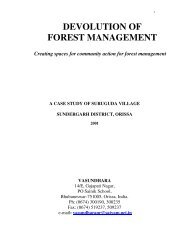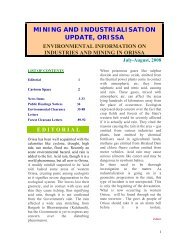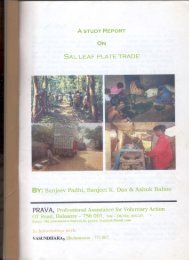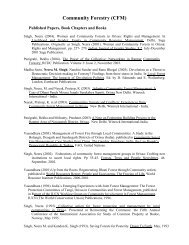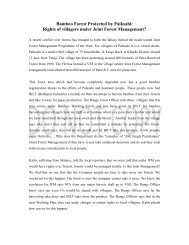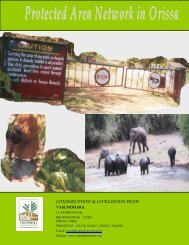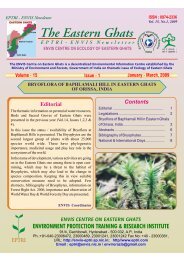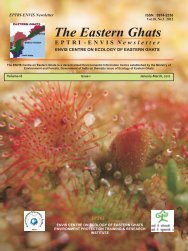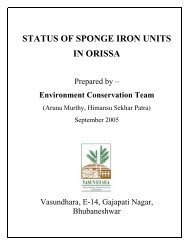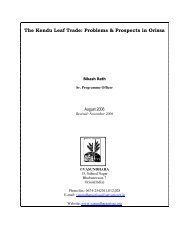Bamboo in Orissa: Trade and Livelihood Perspective - Vasundhara
Bamboo in Orissa: Trade and Livelihood Perspective - Vasundhara
Bamboo in Orissa: Trade and Livelihood Perspective - Vasundhara
You also want an ePaper? Increase the reach of your titles
YUMPU automatically turns print PDFs into web optimized ePapers that Google loves.
All rights reserved by VASUNDHARA(www.vasundharaorissa.org). For any clarification, contact author at sunlit1968@yahoo.co.<strong>in</strong><br />
requirement have also <strong>in</strong>creased the scope of market<strong>in</strong>g the CB. Non-harvest<strong>in</strong>g of forest<br />
bamboo(IB) led to a loss of about Rs. 400 million/year on the bamboo itself, alongwith a<br />
loss of Rs.70 million/year on royalty, Rs.10 million/year on sales tax, Rs.7 million/year on<br />
silvicultural expenses, <strong>and</strong> Rs.105 million/year on labours' wages (Sharda A.K., op.cit.).<br />
Organised market<strong>in</strong>g of forest bamboo started <strong>in</strong> <strong>Orissa</strong> on a large scale when the Bird &<br />
Heilger Co. established its Forest Organisation at Angul dur<strong>in</strong>g the British period. This<br />
company had the largest forest organisation <strong>in</strong> the Eastern India, <strong>and</strong> supplied bamboo to<br />
five states. It also owned paper mills one of which was the TP Mill. Straw Products<br />
Ltd.(later known as JK Crops <strong>and</strong> then as JK Paper) established a similar organisation at<br />
Rayagada <strong>in</strong> 1954 followed by the establishment of its paper mill <strong>in</strong> 1962. These two<br />
companies had the legal status of a lessee.<br />
Follow<strong>in</strong>g is an account of the market<strong>in</strong>g status of various types of bamboo <strong>and</strong> bamboo<br />
products depend<strong>in</strong>g upon their use:<br />
1. <strong>Bamboo</strong> for tenants use:<br />
In Keonjhar state the rates were Rs.10 <strong>and</strong> Rs.5 for 1000 pieces of daba <strong>and</strong> salia<br />
respectively dur<strong>in</strong>g the early decades of 20th century. In Ranpur state, the rates were Rs.1.5<br />
<strong>and</strong> Rs.3 respectively for 100 pieces of salia <strong>and</strong> kanta, <strong>in</strong> 1940s.In Angul Divn, both salia<br />
<strong>and</strong> daba was charged @one anna per 5 pieces(or fraction thereof), <strong>in</strong> 1942. In Ghumsur<br />
North, the rates were 1.5 annas for 10 pieces of salia, <strong>in</strong> 1938-46 (<strong>Vasundhara</strong> 2000<br />
mimeo, Aspects of Garjat Forestry, pp.104,112,232-33).<br />
After <strong>in</strong>dependence, the schedule of rates were revised <strong>in</strong> 1977 for all the districts of the<br />
state. These rates for bamboo however rema<strong>in</strong>ed unchanged for years despite <strong>in</strong>crease <strong>in</strong><br />
the production cost(for OFDC) <strong>and</strong> market prices.<br />
Price of commercial bamboo, supplied by OFDC, varied from Re.0.95 to Rs.3.30 per piece<br />
of salia, <strong>and</strong> from Rs.4.25 to Rs.6 per piece of daba, <strong>in</strong> 1989(proceed<strong>in</strong>g of the meet<strong>in</strong>g of<br />
the Emp. Committee on 23.1.89). In Nov. 2003, the price of salia CB was fixed as under:<br />
Price:<br />
Rs.9.80<br />
<strong>Orissa</strong> Sales Tax(12%): Rs.1.17<br />
Surcharge(@10% over OST): Re.0.12<br />
Rs.11.09<br />
Forest Dev. Tax(1%): Re.0.11<br />
Rs.11.20<br />
Income tax(2.5%): Re.0.28<br />
Additional <strong>in</strong>come tax(2.5%): Re.0.28<br />
Total:<br />
Rs.11.76<br />
Hence, the sale price of salia CB was fixed at Rs.11.76 or Rs.12 per piece. Similarly, price<br />
for daba was fixed at Rs.22.15/piece, plus taxes <strong>and</strong> surcharge(as <strong>in</strong> case of salia).<br />
70



